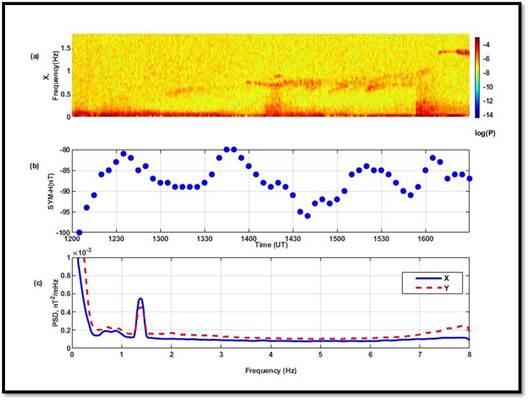
Geomagnetic pearl oscillations increase in the recovery phase of geomagnetic storms
By PIB Delhi
Researchers have traced a very significant increase in special continuous oscillations with pearl-type structures called Geomagnetic Pc1 pearl oscillations on the surface of the Earth in the recovery phase of geomagnetic storms. This study is significant for investigating of precipitation particles during geomagnetic storms and can help us understand the radiation hazard to satellites and astronauts.
Earth’s magnetic field forms a protective shield around us, and various plasma waves are generated in this magnetic field cavity. However, geomagnetic storms often cause a dent in this protection. Energetic particles are either accelerated or lost from the Earth’s radiation belts during these storms. This is responsible for changes in plasma environment leading to growth of low-frequency waves called Electromagnetic ion-cyclotron (EMIC) wave instability which is seen as the magnetic field oscillations (0.1-5 Hz) called as Pc1 pulsations.
The Geomagnetic Pc1 pearl oscillations are amplitude-modulated structured narrow-band signals, which are signatures of low-frequency EMIC waves generated by resonant wave-particle interactions in the Earth’s magnetosphere. The observation of these oscillations is a proxy for the measurement of particle precipitation in the Earth’s magnetosphere.
Evidences of these pulsations are abundant in the mid and high-latitude regions. However, at very low latitude stations, it is not frequent. These waves are an important component of space weather in the near-Earth environment.
A team of scientists at IIG, an autonomous institute of the Department of Science and Technology, along with different Indian and global organization investigated the long-term variability of these pulsations in connection to solar cycles 20-21 and descending phase of solar cycle 24 from very low latitude regions of India.
In the study published in the Journal of Atmospheric and Solar-Terrestrial Physics, the researchers used 13 years of archived records covering solar cycle 20–21 from the equatorial site Choutuppal (CPL, L = 1.03) and 5 years of digital induction coil magnetometer data covering descending phase of solar cycle 24 from the low latitude site Desalpar (DSP, L = 1.07) to investigate the structures of Pc1 waves. The morphological changes during quiet and active geomagnetic conditions were investigated, and the role of ionosphere in bringing the high-latitude EMIC wave to low latitude via ionosphere was modelled.
A clear increase in the number of Pc1 at night was observed compared to the day. This is because the attenuation of Pc1 waves upon propagation via the ionospheric waveguide towards lower latitudes is weaker during night hours. Similarly, during the solar maximum period, the transmission rate of Pc1 waves to the equator was diminished than during the solar minimum. The annual and seasonal patterns of Pc1 occurrence showed an inverse relation with sunspot numbers at both stations. An association of these pulsations with active geomagnetic conditions showed the occurrence of Pc1 increasing significantly in the recovery phase of geomagnetic storms.
The understanding of radiation hazards to satellites and astronauts offered by the study is a great necessity in an era highly dependent on satellite-based communication systems.
Publication link: https://doi.org/10.1016/j.jastp.2022.105963.

Figure 1: Typical disturbed time signature of Pc1 geomagnetic pulsation recorded at DSP in X (a) component on March 17, 2013. Panels (a) show spectrograms of induction magnetometer record, panel (b) shows the equatorial SYM-H index, and panel (c) presents the power spectral estimation of the observed event.



















